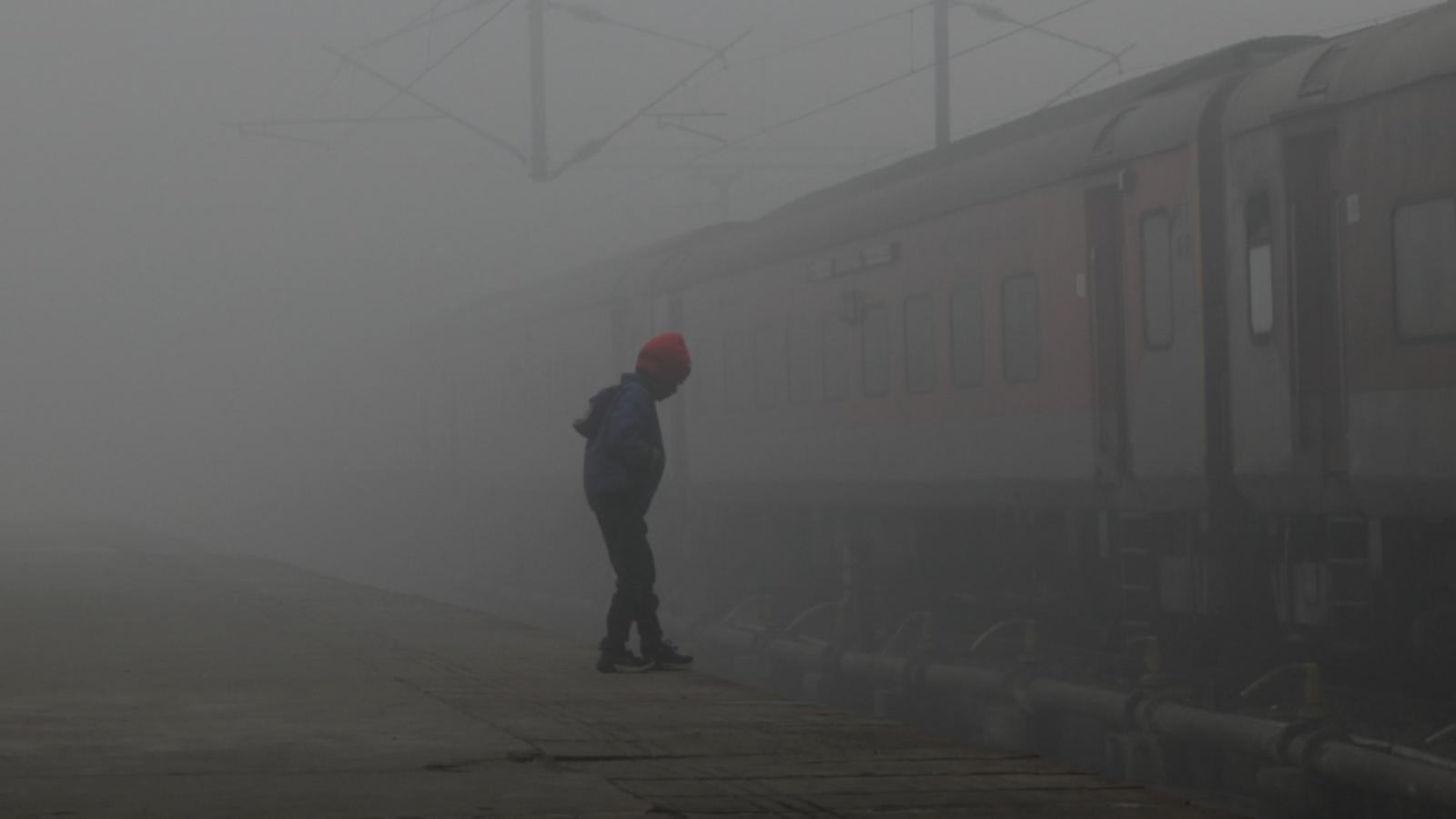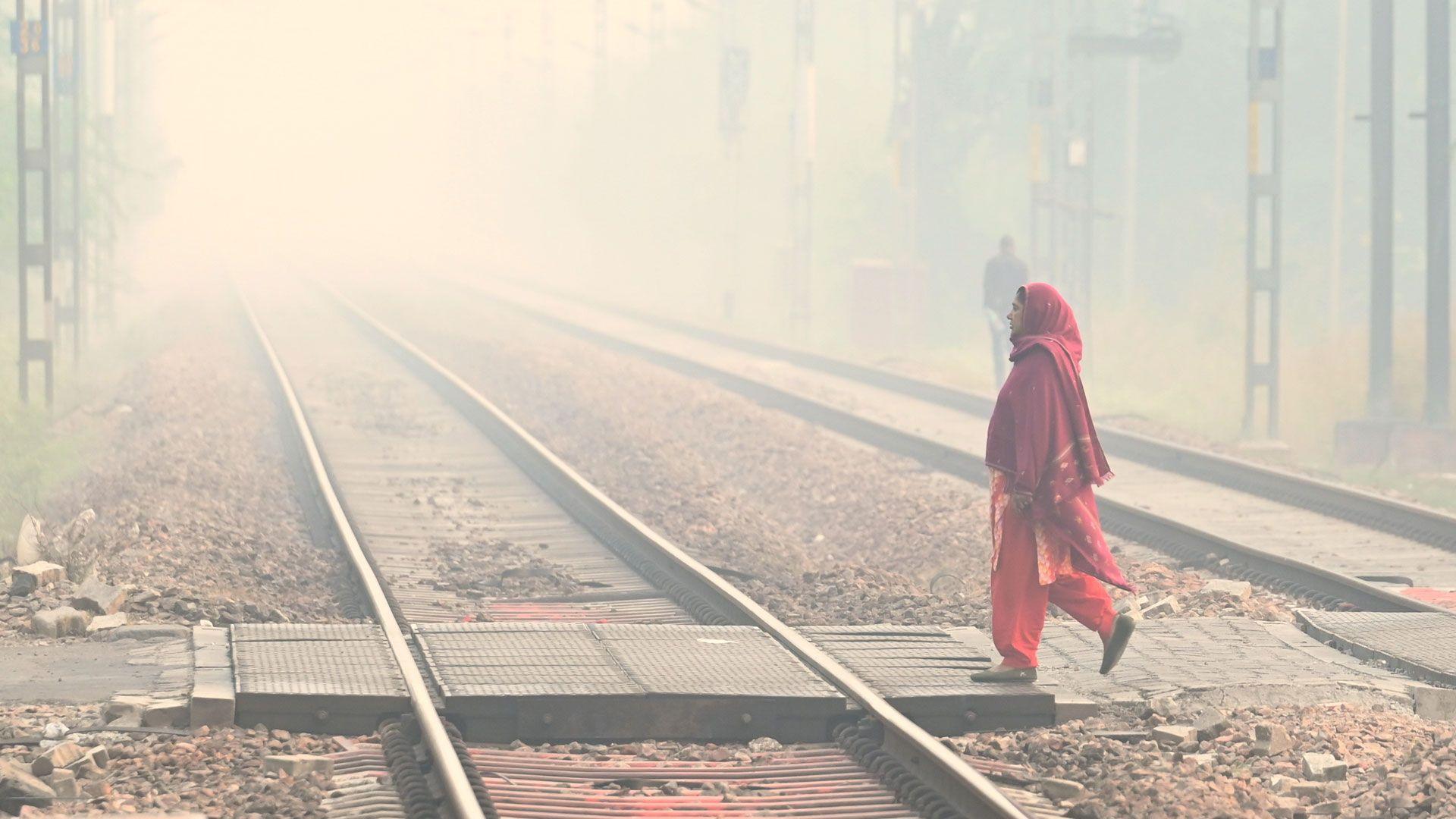'I panic every time she coughs' - Delhi's toxic air is making its children sick

Hospitals in Delhi have seen an influx of children complaining of breathing difficulties
- Published
The toxic haze shrouding the Indian capital, Delhi, spares no-one, but its children are counting the biggest cost of the city's worsening and recurrent pollution problem.
Nowhere is this more evident than at paediatricians' clinics. The BBC visited one such facility in Noida, near Delhi, on a weekday morning a few days back.
In a packed waiting hall outside the doctor's consulting room, anxious parents stood in line with children sneezing, coughing or complaining of breathing difficulties.
Most started falling ill in October, when the capital's air quality dipped to hazardous levels and waiting times for doctor's appointment had stretched longer than usual.
Toxic air is a recurring problem in Delhi and across parts of northern India during the winter.
There isn't a single cause behind the problem, but a mix of factors like low wind speeds, industrial emissions, vehicle exhaust, dropping temperatures and the seasonal burning of crop stubble in neighbouring states.
Since the last month, Delhi's Air Quality Index (AQI) - which measures different types of pollutants, including the level of fine particulate matter PM2.5 that can clog lungs - has been hovering between 300 and 400. This is more than 20 times the limit recommended by the World Health Organization.
Readings above 400 affect all healthy people and seriously impact those with existing diseases, but high exposure to PM2.5 hits children and the elderly the hardest.
Across the capital, many hospitals have seen an influx of children who are sick because of the unbreathable air.
"These particles can affect the child's immunity, especially because their system is still developing and the cells are learning an immune response in the early years," Dr Shishir Bhatnagar, the paediatrician at the Noida clinic, told the BBC.
"These cases have increased tenfold in recent years. In my experience, if I normally see an average 20-30% of patients with such complaints, that number shoots up to 50-70% during the pollution season."
Each year, the government rolls out emergency steps - halting construction, banning polluting vehicles - to curb the smog. This year, it even tried cloud seeding to trigger artificial rain, without success.
But none of it has helped ease the pollution crisis that sparks anxiety among the city's 20 million people - particularly among parents of young children.

High exposure to PM2.5 - or fine particulate matter - hits children the hardest
Khushboo Bharti, 31, says she shudders every time she remembers the night of 13 November, when she had to rush her one-year-old daughter Samaira to the emergency.
"I remember her waking up with a violent cough that made her vomit several times," Ms Bharti says.
She tried the usual home remedies, but nothing worked. Eventually, she took the baby to the hospital in the middle of the night.
"On the way there, Samaira didn't react to anyone or anything. It was very unlike her, she is a bubbly child. She wouldn't even lift her head. It was the worst moment of my life."
At the hospital, the toddler was treated with strong steroid nebulisation and was on oxygen support for two days. She was later diagnosed with pneumonia.
Since then, Ms Bharti is constantly on the edge.
"Even if she coughs just a few times, I panic."
Samaira has now recovered, but other parents like Gopal*, who had to take his two-year-old daughter Renu* to a government hospital last week because of chest congestion, fear that the lethal air may have caused irrevocable damage to their children's health.
"Doctors told me she might have to be on inhalers for some time," Gopal told the BBC.
Research over the years has highlighted the devastating impact air pollution is having on young children across the world - leading to stunted development, external, weaker immunity, external and lower cognitive ability.
A recent study from the University of Cambridge incorporating data from almost 30 million people has also found that exposure to certain pollutants is associated with a higher risk of developing various types of dementia, external, including Alzheimer's disease.
These growing risks have made many parents like Ms Bharti consider moving out of Delhi.
"What is the point of living in a city where my daughter can't even breathe safely?" she asks. "My husband's business is in Delhi, so we can't drop everything and leave. But the moment we have a chance, we'll move."

Women and children protest against air pollution in Delhi
For now, Delhi has moved to limit children's exposure - postponing outdoor sports and shifting primary classes to hybrid mode.
The relatively privileged will benefit from these, but for hundreds of thousands of economically disadvantaged children, born in working class families and living by the roadside or in shanty towns, "the onslaught on their lungs is enormous", Dr A Fathahudeen, a Kerala-based pulmonologist, told the BBC.
Living in cramped homes also exposes them to greater pollution from cooking fuels, traffic and poor ventilation. And the toxic air outdoor makes things worse.
"These children are consistently exposed to high degrees of pollution so their lung defence systems are reduced. If you fail to treat such childhood infections, it can cause permanent damage to the lungs," says Dr Fathahudeen.
He points out that several studies show how early childhood infections caused by the exposure of "immature lungs" to air pollution can lead to chronic obstructive airway disease in adulthood, similar to what's seen among smokers.
Dr Fathahudeen says those who can should strictly keep their children indoors and make sure they are properly hydrated and wear N95 masks - which filter out 95% of the pollutants - when outdoors.
But parents question how long can they keep children shut indoors.
"They're growing, they need space to play and while they do get brief moments in nature, we are now forced to stop them," said Seema*, a mother.
"They protest sometimes, but what choice do we have? We know how crucial physical activity is, but not at the cost of breathing this toxic air," she says.
*Names have been changed
Follow BBC News India on Instagram, external, YouTube,, external X, external and Facebook, external.
Related topics
- Published16 November

- Published14 November 2023

- Published14 June 2022
